|
|
The Air Cannon
OK, here's a couple
of room ideas and a prototype design for the air cannon. These notes were
taken from an halloween-l contest entry from a few years ago. The goal
was to produce a floating ghost that you could potentially walk through....
Ghostly Hallway:
Scene:
Guests enter a long hallway. They immediately hear ghostly sounds all
around. Then, as they enter into the hallway, a loud ghost scream is heard
from behind. A second later, the guests feel and hear the ghosts flying
through the hallway. The clincher is a pepper's ghost at the end of the
hall where the ghost(s) condense into humaniod forms, then scream/shout/point/interact
at the guests.
An extension is where the ghost disappears, then the guests hear and feel
them moving back down the hallway.
Layout:
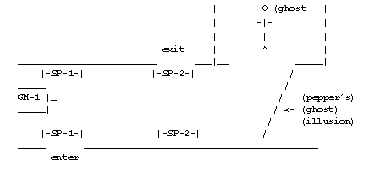
The setup:
Ghost -o-matic, two sets of speakers, a stereo amp, a tape recorder, a
tape loop, dimmable light, plexiglass, plywood, screws, paint, etc.
Air cannon: a joint compound bucket w/latex sheet spread over top and
sealed (duct taped), a 2 inch hole is cut in the center of the bottom.
The latex sheet is connected to the arm of an air ram (from the arm assembly
of trash can trauma) with a serious glob of silicone caulking. The air
ram is triggered by a momentary foot switch connected to an air solenoid.
The footswitch also triggers a cd player and multi-channel haunt timer
(see Automating Your Prop). When the timer counts
down, it triggers a relay connected to a light that illuminates the pepper's
ghost.
Guests enter a long hallway. They immediately hear ghost sounds all around
(SP-1: a set of speakers across the hall from one another, placed just
above ear level). Then, as they proceed a bit into the hallway, a loud
ghost scream is heard from behind (from SP-1). A second later, the air
cannon (GM-1) fires a large pulse down the hallway. A second or two after
that, the screams move down the hallway following the ghost pulses as
if the ghosts are flying through the hallway. Sound movement is done by
panning the sound from SP-1 to a second set of speakers (SP-2). The guests
feel the wind from the air cannon, and hear the ghosts pass by.
The clincher is a pepper's ghost at the end of the hall where the ghost(s)
condense into humaniod forms, turn , then scream/shout/point, etc. The
show could be extended to include another air cannon at the end of the
hallway. After the ghost(s) turn (in the pepper's ghost illusion), they
could enlarge, GM-2 fires, sound pans from SP-2 back to SP-1.
Enhancements:
- Add light materials in
the air stream to enhance the movement. Spider webbing, cheescloth,
shredded cloth, etc. could be used to give visual effect to the air
movement.
- Add fog to the air cannon
and use a blacklight to ehnance the puff.
- Add a slide or video projector
(Andy Oakland's idea) along the axis to illuminate the ghost.
Gary's Air Cannon
Ideas
Here are Gary
Ellison's air cannon ideas he devised.... He may be contacted at his e-mail
address for more information.
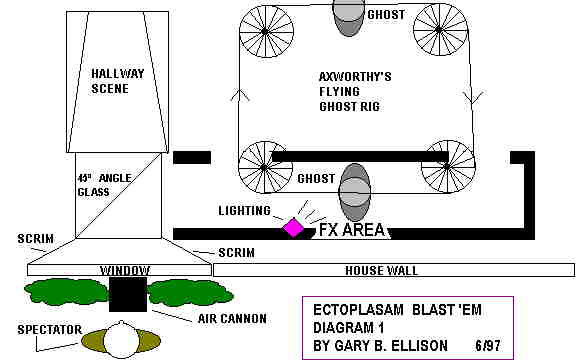
The
Ectoblast
© 1997 Gary Ellison All Rights Reserved
My air cannon
prototype
Version 1: is
a standard air cannon design with a speaker acting as the air piston.
Smoke is injected into the hole before testing.
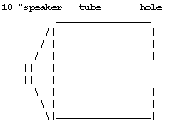
Overview
This version doesn't produce a large volume of air (due to its size),
but it does seem to produce a 'blob' of air instead of a smoke ring! The
secret is in how the 'thump' is produced.
My guess
If I trigger the speaker with a quick pulse, the speaker cone goes out,
then quickly in. Just the same as whacking a membrane. What this does
is push air out the hole, then air is sucked back in immediately as the
speaker cone moves back. The only reasonable explanation I can come up
with is that on the 'push' stroke, there is a much higher air pressure
along the edges of the hole than in the center of the hole due to the
restriction. This higher air pressure moves the 'edge' air out much faster
than the center air. On the return stroke of the speaker, air is sucked
back in through the center of the hole also due to less resistance. This
is what forms the smoke ring: a higher velocity/pressure along the edge
of the hole being forced out, and a canceling effect in the center. Of
course, this is armchair science and assumptions on my part. :)
Anyway, by applying steady current (i.e. DC) for a second or so, the speaker
cone only moves out, the air is forced out from the center first (the
least resistance), and since there isnt anything forcing the air to go
the other way, you get a 'blob' of air.
Pulsing
By repeatedly triggering the unit, I was able to produce a series of smoke
blobs following in a line (shown badly on the photo), almost like morse
code smoke signals!
Details
I began using an 8" speaker and tube with a 2" hole, but this
did'nt produce much of an effect at all. You could just barely feel the
puff at 2 feet away from the hole. Next, I scrounged a 10" speaker
from an old guitar amplifier and a tube from the center of a cable spool
to build a slightly larger unit. On the hole end, I cut a piece of plywood
with a 4" hole. I then cut out several pieces of masonite with various
size holes. The hole size that gives the strongest puff is 1.5".
It produces a puff you can feel up to about 5 feet. I used a 12 volt battery
as the power source.
Increasing the size of the unit made a significant difference in the impact
and distance, Im currently looking/scrounging up parts for a 15"
version.
The Trigger
The speaker is connected to a DC power source (power supply, battery,
etc), any source of switched DC voltage will work; a relay, X-10 momentary
relay controller, momentary switch, etc.
Im using a 12 volt battery and poking the wire onto the speaker terminal
(very unscientific, but very cheap). The speaker produces a puff of air,
and unfortunately, an annoying click somewhat loudly. I reduced this significantly
by adding a 1mfd 25v capacitor across the speaker leads.
Photos
Here's a few pix of the prototype I built...
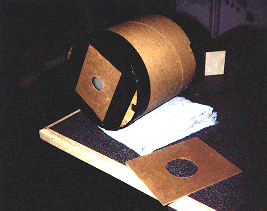
The front of the unit showing hole size testing
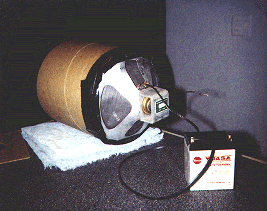
Rear view showing the 'hi-tech' switch :-)
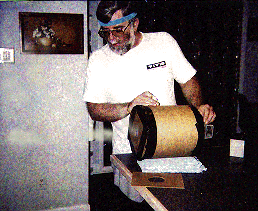
Pulsing little
ghosts out of the air cannon
Index
Back To Top
NOTE:
Before using any information here,
please read our Disclaimer.

Copyright
© 1995-2008 Myth Adventures, Inc.
All Rights Reserved
|







